|
Elwell-Parker, Limited
Paul Bedford Elwell was
born on 7th February, 1853, in Albrighton, the
second son of Wolverhampton merchant, Paul
Elwell. In the 1881 census his occupation is
listed as 'the manager of a works making nails
etc., employing 100 hands'. The Commercial Road
Premises was rented from the owner; J. Smallman.
Elwell founded the Patent
Tip and Horseshoe Company in the early 1870s and
took out several patents. The first for
nail-making machinery was registered in 1876,
the second, registered in 1878 was for shoe
tips, and the third, registered in 1879, was
for Venetian blinds. |
|
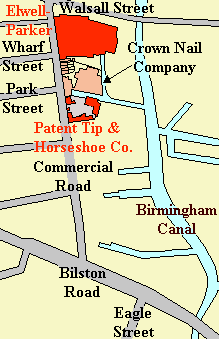
The location of the two
factories. |
Initially the company had
premises on the southern side of the Crown Nail
Company in Commercial Road, by the side of
Commercial Wharf, next to where the power station
stands today. On 17th April 1882 Elwell purchased part of the large factory that
stood on the corner of Lower Walsall Street and
Commercial Road, on the other side of the Crown
Nail Company's works. Further space at the works
was acquired on 24th June. In October 1882 the company
changed direction when Elwell went into
partnership with Thomas Parker to form the first
electrical manufacturing business in the
midlands. Thomas and his family moved to
Wolverhampton from Coalbrookdale, in October
1882.
The new
company was housed in a corner of the Commercial
Road works and Thomas soon added dynamos to his
product range. The electrical department staff
consisted of Thomas, one of his sons and a man.
|
|
In 1883, the company
designed, built, and installed dynamos and
electric lighting for the Trafalgar Collieries
in the Forest of Dean. This was the first
underground electrical installation in the
country, if not in the world. The electrical
equipment included a 1.5hp. motor that was
attached to a pump to lift water 300 feet from
below the surface.
An order was also received
for dynamos from the Manchester Edison Company,
and they were paid a £1,000 in advance. The
rapid success of this part of the business
overshadowed horseshoe manufacture, which soon
ceased; and in 1884 the company became the
Wolverhampton Electric Light, Power, Storage and
Engineering Company. This name was soon changed
to Elwell-Parker, Limited, after an infusion of
fresh capital.
The electrical workforce soon
increased to thirty men and by 1885 the amount
of business had increased to such an extent that
considerable extensions to the premises were
necessary. |
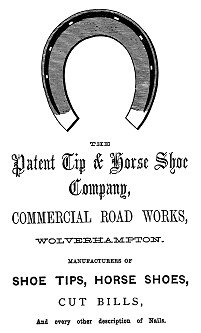
An advert from 1871. |
|
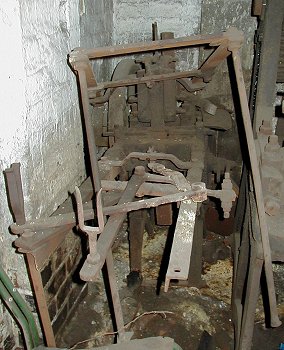
A surviving Elwell nail-making
machine. |
In 1885 Sir William Preece,
speaking before the Royal Society of Arts, said
that the revival of the electricity industry in
this country was due to the efforts and success
of Mr. Parker, and writing in the Royal Society
of Arts Journal, he praised Mr. Parker for
winning a place for Britain in the fast
developing electrical industry. In the same year
Thomas was made a member of the Institution of
Electrical Engineers.
One of the first large
orders secured by the new company was for the
design and construction of the electrical plant
for driving the Blackpool Tramway, the first
English electric tramway of any size.
|
|
Thomas developed a system
of electro-deposition for the refining of copper
and the extraction of gold and silver. Elwell-Parker
made a notable contribution to the electrical
purification of copper, when their dynamos were
installed at the Bolton Copper works at Oakamoor,
and revolutionised the purifying process.
In 1886, Nautilus, the
first electric- powered submarine, was invented
by two Englishmen, Andrew Campbell and James
Ash. On the surface it was powered by two
internal combustion engines, but when submerged
it was propelled by two 50h.p. electric motors.
They were powered from a 100 cell Electric Power
Storage (E.P.S.) battery, which could power the
submarine for as long as four hours, before
recharging was necessary. In 1887 the
submarine was fitted with an Elwell-Parker E.P.S.
battery. |

Thomas Parker. |
|
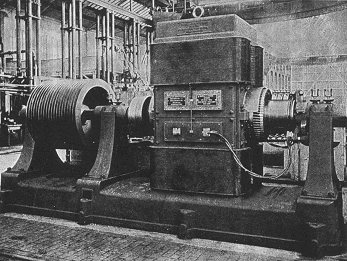
A large Elwell-Parker dynamo. |
In between 1884 and 1887
Elwell and Parker took out no less than 14
patents for electrical equipment, either jointly
or separately. Some of their other electrical
installations included Lloyd's offices in the
Royal Exchange, and Manchester Central Station.
The "Electrician" for 28th January, 1887, stated
that "Messrs. Elwell-Parker have rapidly come to
the front rank of electrical engineers, and
their dynamos and motors are being widely used".
|
| Thomas designed and built
multi-phase alternators with a stationary
armature and a revolving field of the salient
type.
Salient poles were built-up from steel
stampings, either bolted or dovetailed to a
frame. This type of design proved to be very
successful and was used for many years. |
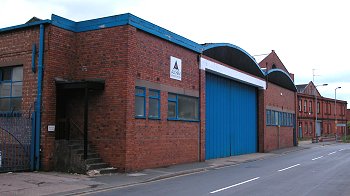
The location of the works next
to the power station. |
|
In 1887 Paul Bedford Elwell
left the company and went to Paris to prepare
plans for the Paris underground electric
railway. He was later responsible for the
electrification of the Sydney tramways and died
there on 10th September, 1899, aged only 46.
In 1887 Thomas Parker
developed a process for the production of
phosphorus, and chlorate of soda, by
electricity, which greatly reduced the
manufacturing costs. The company also
manufactured alternators and supplied their
generating equipment to Eastbourne, Melbourne,
South America, New Zealand, India, and many
other locations throughout the world.
Orders increased, and in
1887 the decision was taken to build a large new
works at Bushbury, on the outskirts of the town.
Land was acquired in Showell Road, but the
project was delayed because of the death of Mr.
Charles Moseley, the company’s Chairman, in
October 1887. |
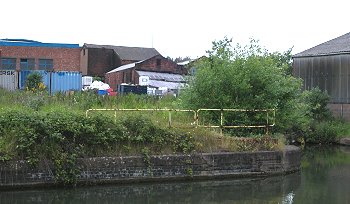
A view of the Elwell-Parker
site from the canal. On the right is what remains of
Commercial Wharf. |
An order was received from
the Birmingham Tramways Company, for the design
and construction of a prototype electric tram,
to run on their existing steam operated system. It was decided that the
tram must be self-powered, as overhead wires
were considered to be unsightly. A
battery-powered prototype was built and
successfully tested at Birmingham, on 7th
November, 1888. It was an instant success and Elwell-Parker expected further orders.
|
|
By 1889 the company had 400
employees, and the works operated both day and
night. In 1889 a large syndicate was formed to
manufacture electrical equipment of the type
already made by Elwell-Parker. The syndicate
founded the Electric Construction Corporation,
Limited and purchased a number of prominent
manufacturing companies to form the new
corporation. Thomas Parker was invited to London
in 1888, to meet Mr. Balfour, from the
Corporation, regarding the purchase of Elwell-Parker,
Limited. Terms were agreed and Elwell-Parker,
Limited was absorbed into the new concern, as
from 30th September, 1888.
On 16th June, 1890 the
factory on the corner of Commercial Road and
Lower Walsall Street was sold to the Electric
Construction Corporation. Presumably the E.C.C.
continued to use the works for some time, as the
factory remained in the company's ownership
until 12th March, 1895 when the buildings were
sold to Thomas Brotherton and Francis Simms. It
is also likely that the E.C.C. continued to use
the other factory in Commercial Road, at least
until their works at Bushbury were in operation.
| To read
the full story about Paul Bedford
Elwell and Thomas Parker visit the
display in the Museum's Electrical
and Electronic Engineering Hall |
 |
|
|
|
|
 |
Return to the Canals
and Industry Menu |
|